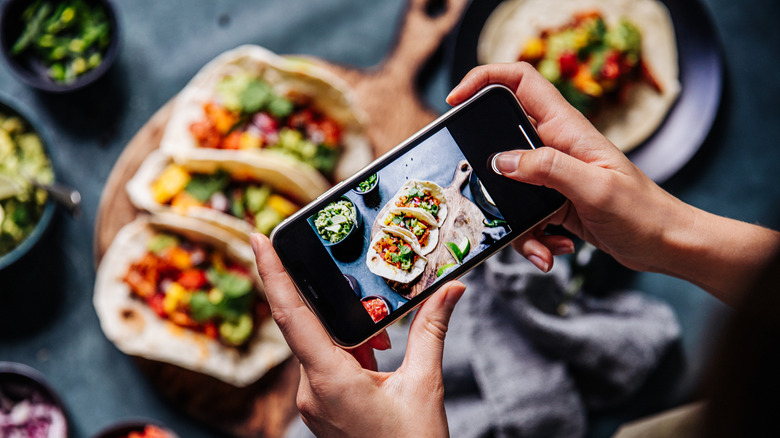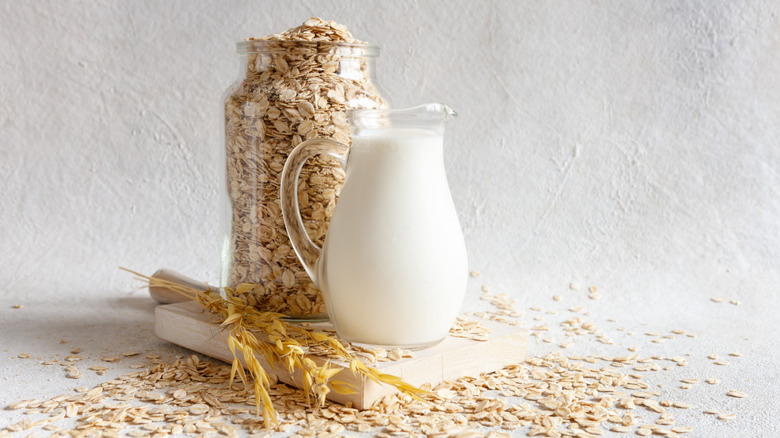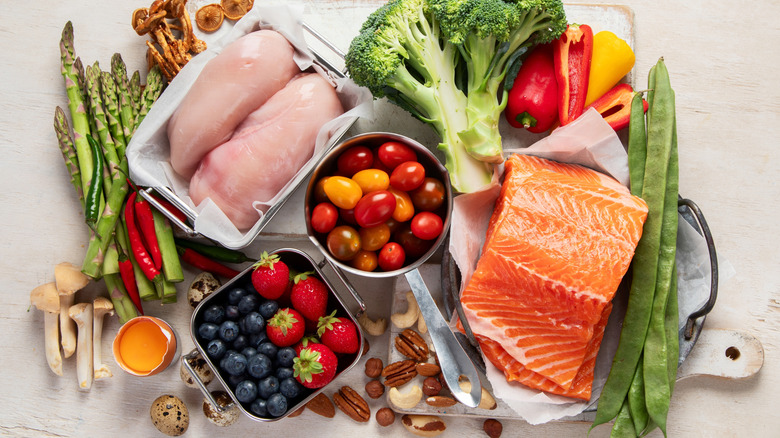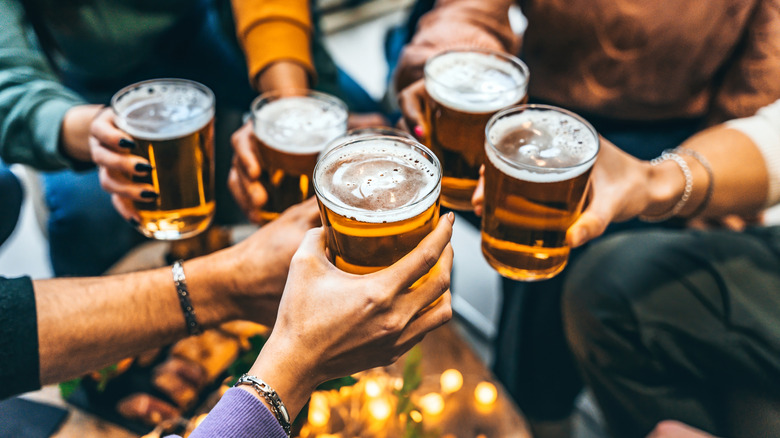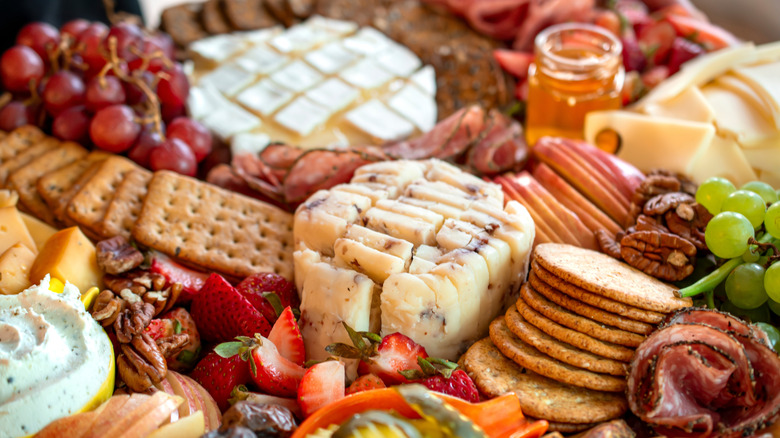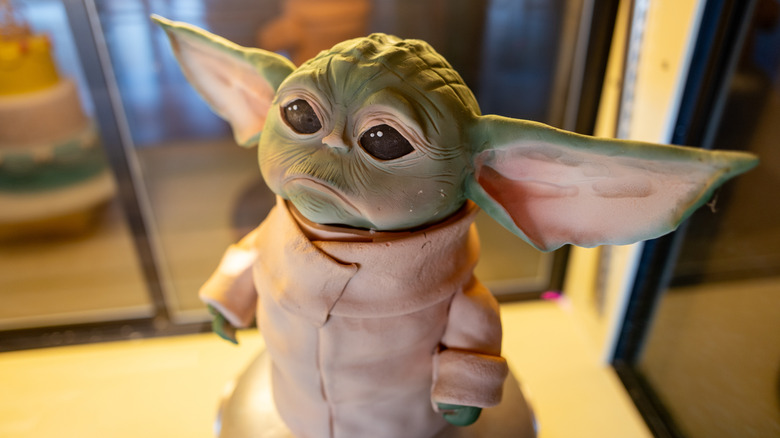Food Trends That Won't Survive 2025
Part of food's appeal has always been visual — but that's never been as true as it is right now. Today, we're not just admiring gorgeous layer cakes in bakery windows as we stroll down the avenue, or peeking through restaurant windows to see what's on diners' plates. We're watching video after video of those layer cakes. These are joined by outlandishly garnished burgers, scrambled pancakes, and ASMR-optimized fried chicken — made and consumed online all day long. All of this has a huge influence on food trends, but not a controlling interest.
Outside social media, craft beer is declining, and breweries will no longer be the in-person community hubs that they seemed for a while. Changes in the alt-milk industry — and the plant-based-food world generally — will spell the end of oat milk's dominance. And with a possible TikTok ban looming, we may also see a return to simpler culinary presentations — cakes decorated with classic piping and beautiful flowers, for instance, rather than cakes decorated to look like exact replicas of the "Star Wars" character Yoda.
Oat milk's dominance in the alt-milk space
Not long ago, oat milk was the plant-based milk of choice for online influencers, wellness promoters, and baristas and their cafe-going customers. It tastes pretty good in a latte, after all, it's creamier than other non-dairy milks, and it's famously better for the environment than other products in this space, like almond milk. As a full mark of its ascension, Starbucks started carrying oat milk in 2021.
The product isn't going away, but its days as the dominant player in alt-milk are numbered. For one, there just might not be enough of the stuff to go around: As demand for this beverage skyrocketed in recent years, farmers have struggled to keep up. But oat milk has also lost its patina of newness, some nutritionists began to take issue with claims that it's better for you than dairy milk, and — the latest in a series of indignities — recent reports have suggested that wellness influencers have begun turning against the stuff, too. This comes amid a broader reshuffling in the area of plant-based foods: After a lot of initial enthusiasm, vegan meats are also experiencing declines in popularity, which is to say declines in sales.
Oat milk is also competing with arrivistes in the alt-milk arena: Trend watchers are forecasting that we'll be eating more pistachios in 2025, with products like pistachio milk increasingly attracting consumers' interest. Still, props to oat milk: You had a pretty good run.
The popularity of keto and other low-carb diets
If you wrote a book about the ongoing saga of fad diets in American life, one of the most recent chapters would definitely be devoted to keto. Short for "ketogenic," this dietary protocol involves eating few carbohydrates and, in their place, a lot of fat. The underlying theory is that this will force the liver to burn fat stored in the body, aiding weight loss.
Though keto and other low-carb diets might have some effectiveness where weight loss is concerned, they have long been controversial among physicians and nutritionists. A study published by the journal Current Problems in Cardiology in 2024 found that, due to eating foods high in saturated fats, keto followers tend to have elevated levels of LDL cholesterol. This is the kind that increases your risk of heart disease. Keto has also been linked to vitamin deficiencies, kidney stones, and other health problems.
Its popularity already seems to be waning. According to a 2023 survey by the International Food Information Council (via Baking Business), 4% of Americans reported following a keto diet — down from the previous couple of years. Google search results for "keto" were declining as well. The nail in the coffin might be Ozempic and other GLP-1s, the new, much ballyhooed class of weight-loss drugs. According to a 2024 report by The New Consumer and Coefficient Capital, "Ozempic" overtook internet searches for "keto." This may signal that consumers might be looking for ways to lose weight that don't involve a highly specialized diet.
Craft breweries as an indicator of cool
In 2024, more craft breweries closed than opened in the U.S. — the first time that's happened since 2005. In the 20 years between, of course, this country has enjoyed a craft beer explosion. We've got more fancy beer to drink than ever. But more than that, craft breweries gained a ton of cultural cachet. They were surefire indicators of up-and-coming neighborhoods and artsy little cities; they became community spaces where adults could bring their kids and still hang out and have a pretty good time.
But now they're losing some of that cachet. Why the decline in popularity? Some have attributed the industry's struggles to creative stagnation (does anybody really need another hazy IPA?). But it also has to do with the rising costs of ingredients and with the tastes of younger consumers, who are famously turning away from alcohol — and, when they do drink, leaning more toward spirits and non-beer products like hard seltzer. While craft breweries aren't about to disappear from the drinking landscape anytime soon, they're also not the cultural hubs they once were — the ones that are still open, anyway.
Supersized charcuterie boards (and other extravagant board spinoffs)
When did the charcuterie board jump the shark? Was it when people started making butter boards — essentially, a bunch of butter spread across a wooden board, often with questionable sanitation practices? Was it when salami and cheese gave way to gummies and chocolate-dipped strawberries — i.e., when "candy boards" became a thing? Or was it when the charcuterie board itself, previously a manageably proportioned hors d'oeuvres platter, became supersized, even table-sized? The thing about a charcuterie board is that it looks great before anybody starts picking at it; as the party wears on, it looks rougher and rougher. Sweaty salumi. Scattered olive pits. Cross-contaminated cheese knives. Supersize that.
But, just as economic inflation is finally slowing down, the era of the inflated charcuterie board is itself coming to an end. Butter boards, thank goodness, are already fading from prominence. And one analysis showed that conversations on social media channels about "charcuterie" declined by nearly a third over the past year. Much of the charcuterie-board inflation can be attributed to TikTok — whose days as a driver of American food culture, as discussed above, are now numbered. The charcuterie board will always be with us — it's a classic for a reason — but here's hoping it'll go back to its most ideal form: a nice little snacky spread of meats and cheeses that, like an old friend, you're always happy to see at a party. Here's how to build a perfect charcuterie board of your own.
Hyperrealistic cakes decorated with fondant
Fondant, a type of icing used for finishing cakes, consists of little more than sugar, water, and ingredients that make it easy to shape, like gelatin — it's much more about look than taste. Fondant can be poured onto a cake or, if made thicker, rolled out like clay and sculpted into shapes like flowers. It is a key ingredient in the recent trend toward elaborate, highly polished cakes that viewers loved on shows like "Cake Boss," and that spread around the internet in the "Everything is cake" trend. For the latter, clever creators would put a real-life object — a shoe, let's say — beside an identical version made of cake; the trick was that it was impossible to tell the difference. This meme, of course, also ended up as a show: Netflix's "Is It Cake?"
But fondant's moment has passed. Redditors grew tired of fake cake years ago. A particular ire has been expressed from various corners toward this one kind of icing, which doesn't really taste like anything and — some claimed — acted as a kind of shortcut around the skilled work of decorating with a piping bag. In the wake of their hyperrealism era, trendy cakes seem to be returning to more naturalistic, even rustic vibes: bare-sided "naked" cakes, nostalgic decorating styles, lots of fresh flowers. And no, those don't just look like flowers — they're the real thing. They might not have fondant's staying power, but that's the point.
